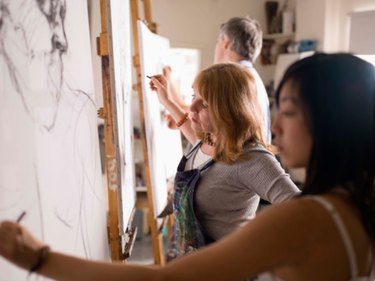Things You'll Need
Photograph
Tracing paper
Pencil
Straight edge
Triangle
Proportional scale
Light table
Light box
Window

Many artists use mechanical aids to assist them in the creation of their art. There is an expressed disdain for these aids but in the quiet of the studio anything and everything is used to try to create the exact type of art the artist envisions. Tracing paper is one of those tempting aids, particularly when an artist is learning how to draw portraits. Because a camera can capture a face so easily, it seems natural to use a camera image as a foundation for drawing a face. While this is one way to develop proportional skills, if you rely on a camera image and tracing paper your portraits will suffer from single-eye syndrome.
Grid Tracing Paper Technique
Step 1
Place a photograph of a person's face on the drawing table. Tape the image down. Position tracing paper over the image. Draw a grid on the tracing paper.
Video of the Day
Step 2
Position tracing paper over the image. Tape the tracing paper down. Draw a grid on the tracing paper.
Step 3
Transfer the grid to a larger size of paper using a proportional scale to convert the grid from one size to another. Proportional scales can be found at art stores. This grid will allow you to section off the photograph to estimate the enlarged size.
Tracing Over A Photograph
Step 1
Enlarge the photograph to the size you wish to draw. This is how tracing paper is often used by inexperienced artists. Tape the enlargement to the drawing table.
Step 2
Tape tracing paper over the enlargement and trace the shape and detail of the face you are drawing. After the drawing is well-detailed, place the tracing paper on a light table, light box or on a window that receives good sunlight. A strong light table used in a darkened room can allow the artist to see through several layers of paper, particularly if one of the papers is thin, like tracing or copier paper.
Step 3
Tape drawing Bristol board over the tracing paper. The thinness of the tracing paper will allow you to see the lines through the Bristol board. Retrace the drawing onto the Bristol board. Remove the Bristol board, position the original photograph nearby and refine the details on the Bristol board.
Tip
This technique can produce a near photo-realistic drawing when it is carefully done. The problem is that a camera uses a single eye or lens while the human sees with two converging lenses. No two-eyed human actually sees like a camera, so a photo-realistic drawing never achieves the composition of the human artist who draws what he actually sees. The viewer of the art will know that something isn't quite right with the drawing, even if she can't tell you what it is.
Video of the Day